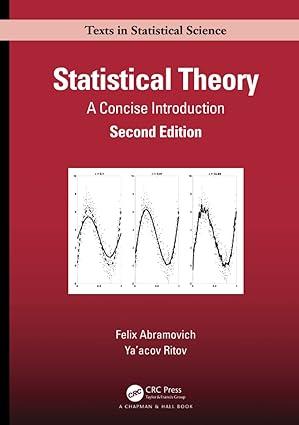Exercise6.2 Three friends,Optimist,RealistandPessimist,gotoacasino.Theydecidetoplaya gamblinggameforwhichtheydonotknowtheprobability p of winning.Motivatedbyanexciting lecture onBayesianstatistics,theydecidedtoapplyBayesiananalysistotheproblem.Optimist chose aprioron p from theconjugatefamilyofdistributions.Inaddition,hebelievesthatthe chances are50%-50%(i.e. E(p)=1/2)
Question:
Exercise6.2 Three friends,Optimist,RealistandPessimist,gotoacasino.Theydecidetoplaya gamblinggameforwhichtheydonotknowtheprobability p of winning.Motivatedbyanexciting lecture onBayesianstatistics,theydecidedtoapplyBayesiananalysistotheproblem.Optimist chose aprioron p from theconjugatefamilyofdistributions.Inaddition,hebelievesthatthe chances are50%-50%(i.e. E(p)=1/2) with Var(p)=1/36. Realistchoseauniformprior U (0,1).
1. ShowthatbothpriorsbelongtothefamilyofBetadistributionsandfindtheparametersforthe priors ofOptimistandRealist.
2. Pessimist doesnothaveanypriorbeliefsanddecidedtochoosethenoninformativeJeffreysprior.
What ishisprior?DoesitalsobelongtotheBetafamily?
3. Being poorstudentsofStatistics,Optimist,RealistandPessimistdonothaveenoughmoneyto gambleseparately,sotheydecidedtoplaytogether.Theyplayedthegame25timesandwon12 times. Whatistheposteriordistributionforeachoneofthem?
4. Find thecorrespondingposteriormeansandcalculatethe95%Bayesiancredibleintervalsfor p for eachstudent.
(Hint: usethefactthatif p ∼ Beta(α,β) and ρ = p 1−p is theoddsratio,then βα
ρ ∼ F2α,2β )
5. The threefriendstoldtheirclassmateSkepticabouttheexcitingBayesiananalysiseachoneof them hasperformed.However,Skepticis,naturally,skepticalabouttheBayesianapproach.He does notbelieveinanypriorsanddecidedtoperforma“classical”(non-Bayesian)analysisof the samedata.Whatishisestimateandthe95%confidenceintervalfor p? Comparetheresults and commentonthem.
Step by Step Answer:

Statistical Theory A Concise Introduction Texts In Statistical Science
ISBN: 9781032007458
2nd Edition
Authors: Felix Abramovich, Ya'acov Ritov






